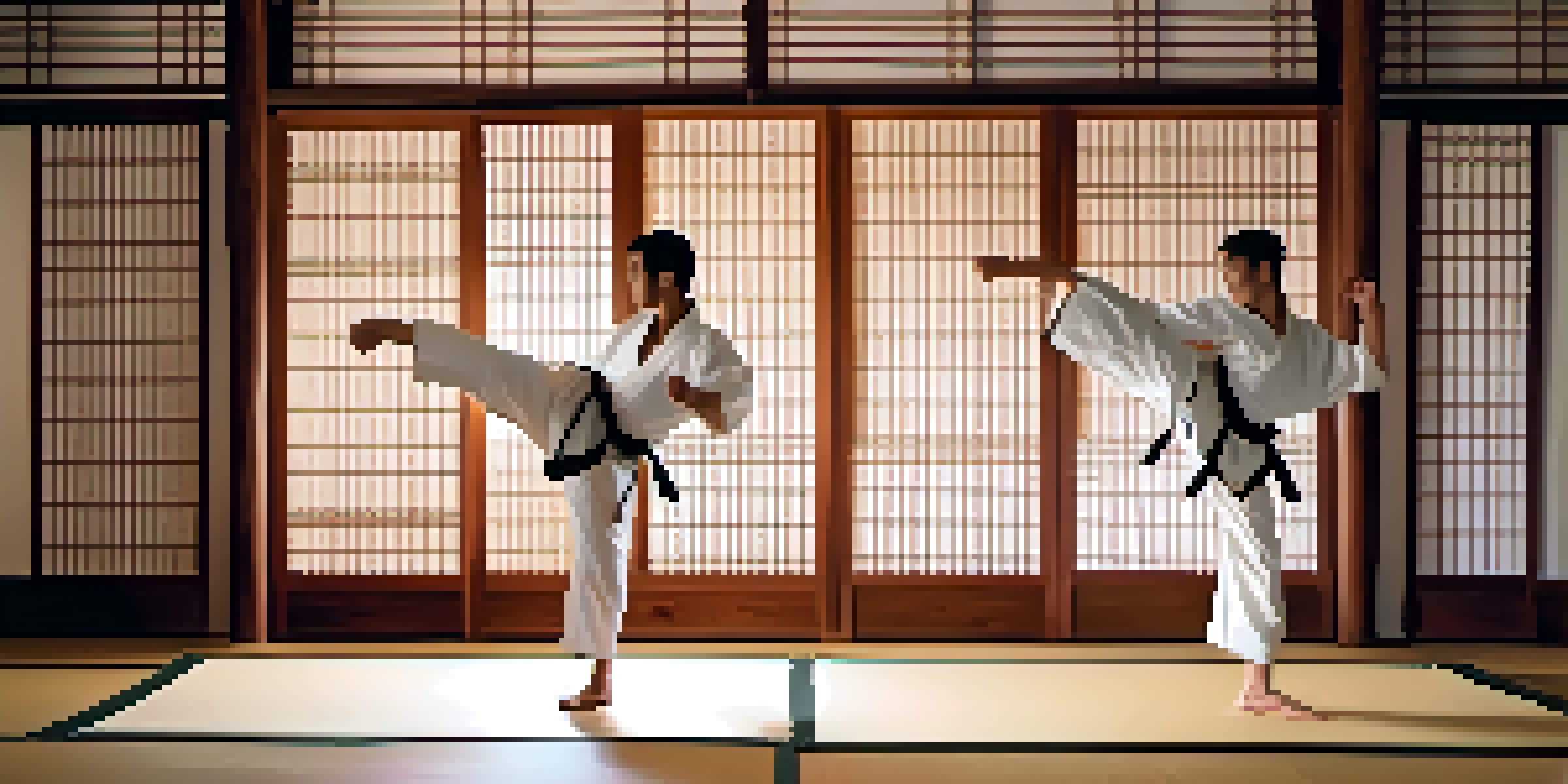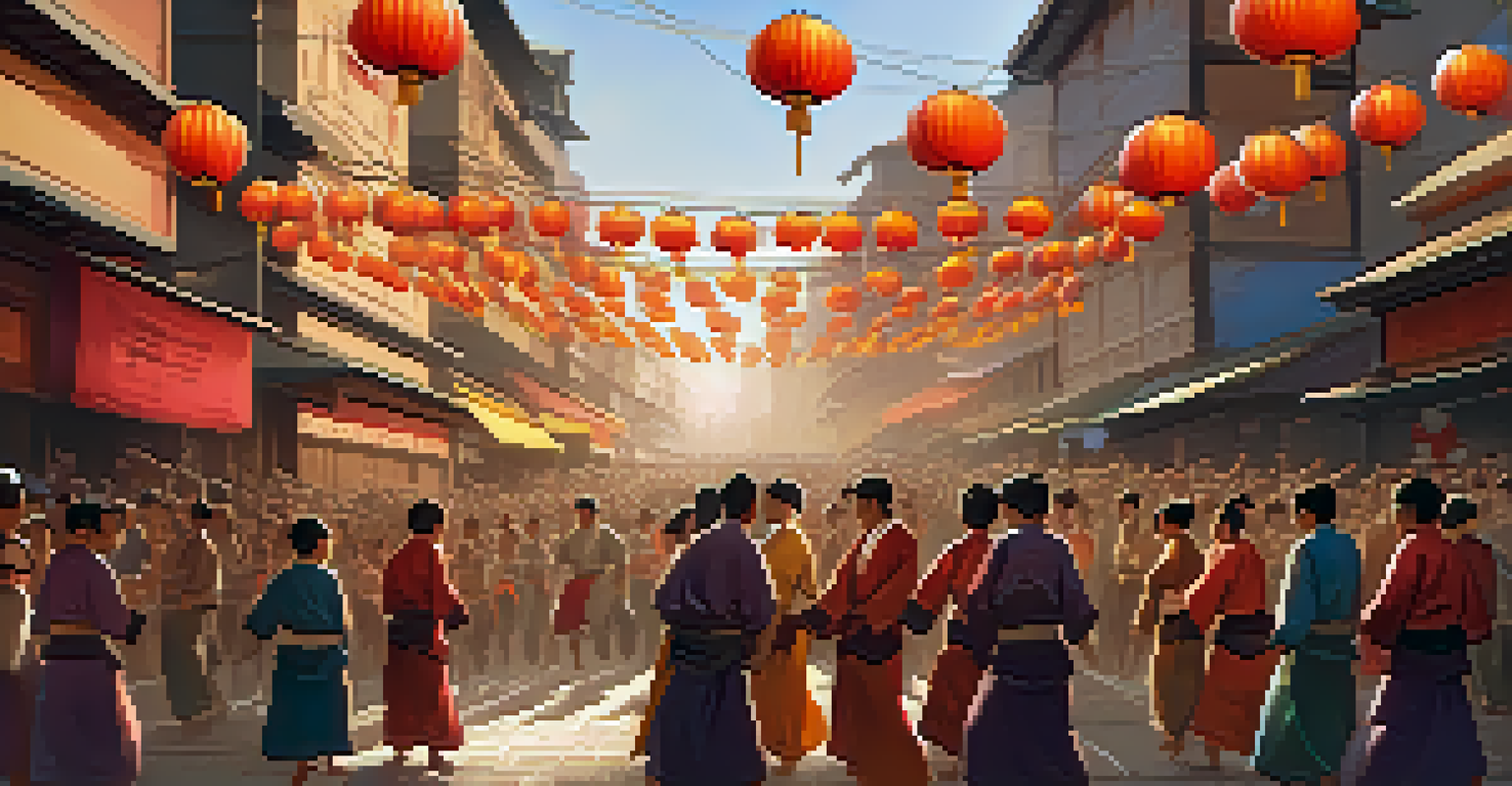The Role of Music in Enhancing Martial Arts Fight Scenes

Setting the Mood: The Importance of Soundtracks
Music plays a pivotal role in establishing the mood of a fight scene. A well-chosen soundtrack can evoke emotions ranging from tension to exhilaration, creating an immersive experience for the audience. For instance, think about the iconic tracks in movies like 'Kill Bill' or 'The Matrix'—each piece of music enhances the cinematic experience.
Music is the shorthand of emotion.
The right soundtrack not only complements the visuals but also heightens the stakes of the fight. When the beat drops or crescendos, it can sync perfectly with pivotal moments, making those punches feel more impactful. This connection between sound and action makes the scene more memorable and engaging.
Moreover, a powerful soundtrack can give insight into the characters' internal struggles and motivations. The music can reflect their fears, desires, or determination, adding depth to the action. Without this auditory layer, fight scenes might feel flat and lose their emotional resonance.
Building Tension: The Role of Rhythm and Tempo
Rhythm and tempo are crucial elements in creating suspense during martial arts scenes. A slow, steady beat might build anticipation, while a fast-paced tempo can create a sense of urgency and chaos. This manipulation of musical speed can guide the audience's emotional response as they watch the choreography unfold.

For example, in a showdown where two fighters are sizing each other up, a slow, tense rhythm can amplify the suspense. As the fight escalates, the tempo can shift to match the rapid movements and intensity of the action. This ebb and flow of music mirrors the dynamics of the fight, enhancing the viewer's experience.
Music Sets the Mood for Action
A well-chosen soundtrack enhances fight scenes by evoking emotions and creating an immersive experience for the audience.
Additionally, pauses in music can be just as powerful as the sounds themselves. A sudden silence right before a climactic moment can make the audience hold their breath, making the ensuing action even more thrilling. This interplay of rhythm and silence is what makes fight scenes truly captivating.
Creating Character Themes: Music as Identity
Just like superheroes have their signature themes, martial arts characters can also be defined by their music. A character's unique soundtrack can serve as a musical identity, helping the audience connect with them on a deeper level. Think of how the theme for a character in a fighting game instantly brings their persona to life.
The music can reflect their fears, desires, or determination, adding depth to the action.
For example, a villain might have a dark, menacing score that foreshadows their ruthlessness, while the hero might be accompanied by an inspiring melody that embodies their courage. This distinction not only enhances character development but also allows the audience to feel a sense of loyalty or animosity towards them.
These musical motifs can be revisited throughout the film, reinforcing the character's journey. Each time that theme plays during a fight scene, it can trigger specific emotions, memories, or expectations, making the fight feel even more personal and engaging.
Synchronization: The Dance of Music and Movement
Synchronization between music and movement is a hallmark of choreographed fight scenes. When the actions of the fighters align perfectly with the beats of the music, it creates a mesmerizing effect that captivates viewers. This synchronization turns a simple fight into a dance of power and grace, transforming the mundane into the extraordinary.
Take a moment to consider a well-executed fight scene where punches, kicks, and dodges seem to dance in harmony with the soundtrack. This visual and auditory synchronization elevates the action, making it more thrilling and engaging. It’s like watching a ballet, where every movement is intentional and beautifully timed.
Rhythm Builds Tension and Suspense
Manipulating rhythm and tempo in music can heighten anticipation and excitement during martial arts choreography.
Moreover, this connection can enhance the storytelling aspect of the fight. As the music rises and falls with the action, it can highlight moments of triumph, defeat, or desperation, allowing the audience to feel the weight of each blow. This dynamic interplay is what makes martial arts scenes unforgettable.
Cultural Significance: Music in Martial Arts Traditions
Music has long been integral to various martial arts traditions around the world. In many cultures, music accompanies training and performances, adding an element of rhythm and flow to the practice. This cultural significance enriches the martial arts experience, creating a deeper connection between the fighters and their heritage.
For instance, traditional Chinese martial arts often incorporate music in their forms, enhancing the fluidity and grace of movements. The sounds of drums or bamboo flutes can elevate the practice to a spiritual level, resonating with the philosophy behind the martial art. This cultural infusion helps to convey the values and history of the discipline.
When filmmakers incorporate these traditional elements into fight scenes, they not only honor the martial art but also create a more authentic experience for viewers. This blend of music and movement can transport the audience to a different time and place, deepening their appreciation of both the art form and the cinematic experience.
Emotional Resonance: Music as a Narrative Tool
Beyond setting the mood, music serves as a narrative tool that can shape the emotional landscape of a fight scene. It can underscore the stakes involved and amplify the feelings of the characters, drawing the audience into their struggles. The right score can make viewers feel every punch, kick, and moment of vulnerability.
For instance, a bittersweet melody playing during a climactic fight can evoke feelings of nostalgia or longing. This emotional layer can transform a physical confrontation into a poignant moment, where the audience feels a connection to the characters and their journey. It’s this ability to evoke emotion that makes music such a powerful ally in storytelling.
Music Enhances Character Identity
Unique musical themes help define martial arts characters, fostering deeper connections with the audience.
Moreover, the emotional resonance created by music can linger long after the scene ends. It can leave a lasting impression, making the audience reflect on the complexities of conflict and resolution. This lasting impact is what makes certain fight scenes not just memorable, but truly iconic.
Conclusion: The Indispensable Role of Music in Fight Scenes
In conclusion, the role of music in enhancing martial arts fight scenes cannot be overstated. From setting the mood to creating emotional resonance, music is an indispensable element that elevates the cinematic experience. It transforms choreography into art, making fight scenes not just visually stunning but also deeply engaging.
As filmmakers continue to explore innovative ways to incorporate music into their narratives, we can expect to see even more captivating fight scenes in the future. The symbiotic relationship between music and movement will undoubtedly keep audiences on the edge of their seats, eager for more.

Ultimately, the blend of music and martial arts speaks to a universal truth: that every fight tells a story, and the right soundtrack can make that story unforgettable. So next time you find yourself captivated by a thrilling fight scene, take a moment to appreciate the music that makes it all come alive.